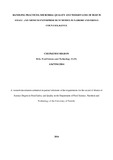| dc.description.abstract | In Kenya, small and medium enterprise butcheries are faced with a number of challenges, especially poor sanitation and hygiene meat handling practices. This exposes meat to contamination by pathogenic and spoilage microorganisms leading to foodborne illnesses and meat post-harvest losses.
The current study was designed in three phases, each phase covering a specific objective. The first part of the study aimed at assessing sanitation and hygiene beef handling practices in small and medium enterprise butcheries in Nairobi and Isiolo counties. A cross-sectional survey was conducted among 134 and 71 randomly selected butcheries using semi-structured and pre-tested questionnaires in Nairobi and Isiolo counties, respectively.The second objective involved determination of microbial quality of beef in small and medium enterprise butcheries in Nairobi County, Kenya. A total of 150 meat and surface swabs samples were collected and subjected to total viable counts, total coliform counts, S.aureus, E.coli, Pseudomonas Spp. and Listeria Spp. The third objective assessed beef weight loss in small and medium enterprise butcheries in Nairobi County, where 6 small and medium enterprise butcheries were randomly selected.
It was found that there was high participation of more educated youth (20-35 years) in butchery operations in Nairobi County compared to middle age (31-40 years) in Isiolo County. Seventy percent and 82% of operators in Nairobi and Isiolo counties respectively did not wear protective clothing. About ninety and 88% of operators in Nairobi and Isiolo Counties respectively did not possess medical certificates. Most (86% and 69%) of operators in Isiolo and Nairobi counties respectively had no training on meat handling hygiene. The study established that 60% and 82% of operators in Nairobi and Isiolo Counties respectively did not wash their hands before handling meat. Higher (90% and 87%) proportion of operators in Isiolo and Nairobi Counties, respectively handled meat concurrently with handling money. Majority (60% and 34%) of operators in Isiolo and Nairobi Counties, respectively cleaned utensils by wiping with reused cloth. The study established that 50% and 27% of operators in Nairobi and Isiolo counties respectively used closed vehicles to transport
xv
meat from the slaughterhouse to the butcheries. About 83% and 47% of the operators in Isiolo and Nairobi counties, respectively stored meat by hanging it in open space in butchery.
Microbiological results obtained indicated that, the highest mean TVCs (4.52 log CFU/cm2) was from flank and the highest mean Listeria spp counts (2.17log CFU/cm2) being from briskest of the beef from the butcheries. The highest mean E.coli counts (2.18 log CFU/cm2) were observed from the neck while the highest mean Pseudomonas spp counts (3.59 log CFU/cm2) were from cavity. It was found that the mean TCC was highest (3.39 log CFU/cm2) from the neck whereas the mean S.aureus counts were highest (3.85 log CFU/cm2) from cavity. There was significant (p<0.05) difference in mean Pseudomonas Spp. counts from meat samples. S.aureus counts significantly (p<0.05) differed from personnel hands and clothing.
The mean temperature of the air in the butchery ranged 22.4-24.50C while relative humidity of the air ranged 68.7-83.7% during the study period. Beef weight loss significantly (p<0.05) differed among the butcheries. The study established that the relative humidity of the air was significantly and negatively (r= -0.928, p<0.05) correlated to beef weight loss while the temperature of the air showed a positive (r=0.551) correlation with beef weight loss with no statistical significance (p>0.05). Beef weight loss showed a positive statistical significant(r=0.9, p<0.05) relationship with weight of portioned meat.
The study revealed that majority of small and medium enterprise butchery operators from Nairobi and Isiolo counties did not adhere to the required sanitation and hygiene standards, low microbial meat quality with respect to L.monocytogenes, S.aureus, E.coli and Pseudomonas Spp with high beef weight loss. Training of butchery operators on sanitation and hygienic meat handling can be a way of preventing meat contamination hence avoiding possible occurrence of foodborne illness and meat post-harvest losses. | en_US |

